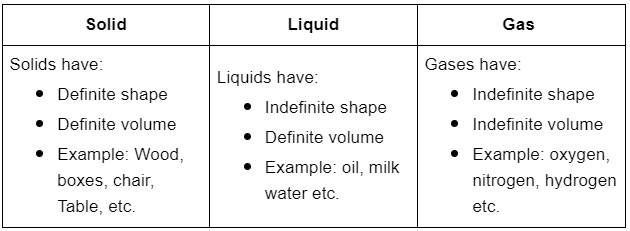Long Questions: Separation of Substances | NCERT Summary: UPSC PDF Download
Q1: Name three states of matter and their characteristic properties?
Ans: Solid, liquid, and gas are the three states of matter.
Characteristics of solid, liquid, and gases are listed below: 
Q2: Describe an experiment to show that the palm is translucent?
Ans: The experiment consists of the following steps:
- With the help of your palm, cover the glass of a torch in the dark place.
- Switch on the torch.
- Observe the light from the other side of the palm.
Observation: Some part of the light passes through the palm but not all passes through it. This shows that our palm is translucent.
Q3: Why is the grouping of the objects helpful?
Ans: Objects must be grouped in order to be easily and quickly located. It's also useful to know whether the grouped objects are finished or not. This is especially useful for shopkeepers. He'll be able to tell if his stock is finished or not.
Q4: Explain the process of winnowing. What types of materials can be separated using this method? Provide an example.
Ans: Winnowing is a method used to separate heavier particles from lighter particles using the wind. It is mainly used to separate husk, dirt, and dust from grains like wheat or rice. In this process, the mixture is allowed to fall from a certain height. As the mixture falls, the wind carries away the lighter particles (like husk and dust) while the heavier grains fall down due to their weight. For example, when we throw a mixture of rice and husk in the air, the husk gets blown away by the wind, leaving behind the rice grains.
Q5: Describe the process of filtration. When is it commonly used in our daily lives?
Ans: Filtration is a method used to separate insoluble solids from liquids using a filter. In this process, a mixture is poured through a filter paper or a porous material like a cloth. The liquid portion, which is called the filtrate, passes through the filter while the solid particles are left behind on the filter. Filtration is commonly used in our daily lives for tasks like making tea. When we pour tea through a tea strainer, the tea leaves are left behind on the strainer, and the filtered tea passes through.
Q6: Explain how sedimentation and decantation work together to separate a mixture of water and sand. Provide steps for this process.
Ans: Sedimentation and decantation are two processes used to separate a mixture of water and sand.
Here's how they work together:
- Sedimentation: Allow the mixture to stand undisturbed for some time. Due to the difference in densities, the heavier sand particles settle down at the bottom of the container, while water remains above it.
- Decantation: Gently pour off the clear water from the top into another container. Be careful not to disturb the settled sand at the bottom. This process helps in separating the sand and water.
By following these steps, you can effectively separate sand from water using sedimentation and decantation.
Q7: Describe the method of sieving. Provide an example of a situation where sieving is used for separation.
Ans: Sieving is a method used to separate a mixture of particles of different sizes. It involves passing the mixture through a sieve or a sieve-like tool. The sieve has holes of a particular size that allows smaller particles to pass through while larger particles are left behind. For example, when we use a flour sifter in the kitchen, the fine flour passes through the small holes, while any lumps or larger particles remain in the sifter.
Q8: Explain the process of evaporation. How can we separate a dissolved solid from a liquid using evaporation? Provide an example.
Ans: Evaporation is a process in which a liquid is heated, and it changes into vapor or gas state. To separate a dissolved solid from a liquid using evaporation, follow these steps:
- Take the mixture in a container.
- Heat the mixture gently. As the liquid heats up, it turns into vapor and rises, leaving behind the solid particles.
- Once all the liquid has evaporated, you are left with the solid residue in the container.
An example of this process is the separation of salt from seawater. When seawater is heated, the water evaporates, leaving behind the salt crystals.
Remember, these methods of separation are essential in various aspects of our lives, from food preparation to industrial processes.
Q9: Explain the process of handpicking as a method of separation. Give an example where handpicking is used for separating substances.
Ans: Handpicking is a simple method of separation where different components of a mixture are separated by hand based on their distinct properties. This method is effective when the components have noticeable differences in size, shape, color, or texture. For example, when you sort a collection of pebbles to gather only the smoothest ones for a decorative purpose, you are using the handpicking method of separation.
Q10: Describe the process of using a magnet for separation. Provide a real-life scenario where this method is applied.
Ans: Magnetic separation is a method used to separate materials containing magnetic properties from those that do not. It involves the use of a magnet to attract and separate magnetic materials from a mixture.
Here's an example scenario: Suppose you have a mixture of iron filings and sand. To separate these two components, you can use a magnet. By moving the magnet through the mixture, the iron filings will be attracted to the magnet and stick to it, leaving the sand behind. This method is commonly used in recycling centers to separate magnetic materials like iron or steel from non-magnetic materials in waste streams.
|
666 docs
|

|
Explore Courses for UPSC exam
|

|
















